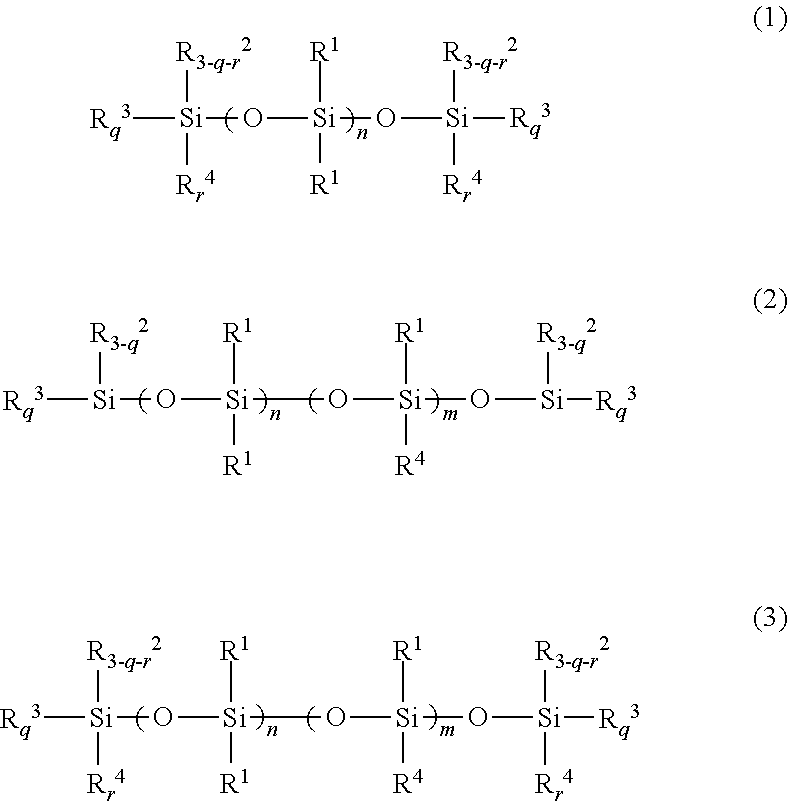Microemulsion composition and a fiber treating agent
a technology of fiber treatment agent and microemulsion composition, which is applied in the field of microemulsion composition and fiber treatment agent, can solve the problems of difficult preparation of transparent microemulsions having a mean particle diameter of 50 nm or less, production process, and inapplicability, and achieve good storage good softness, and good stability and dilution ability
- Summary
- Abstract
- Description
- Claims
- Application Information
AI Technical Summary
Benefits of technology
Problems solved by technology
Method used
Image
Examples
examples
[0074]The present invention will be explained below in further detail with reference to a series of the Examples and the Comparative Examples, though the present invention is in no way limited by these Examples.
[0075]The viscosity described in the Examples was as determined at 25 degrees C. by a BM type viscometer, ex. Tokyo Keiki, Inc. The volatile matter content was as determined in a residue-on-heating method by a hot air circulation type thermostat, ex. Yamato Science, Co., Ltd. The HLB factor was calculated based on Griffin Method, i.e. HLB factor=20×(total formula weight of hydrophilic parts / molecular weight).
preparation 1
[0076]In a separable flask having a volume of 500 ml, provided with a thermometer, a stirrer, a reflux condenser and a gas introduction tube, placed were 100 g of an aminoalkyl group-containing organopolysiloxane represented by the following formula (A), having a molecular weight of 4066, an amine equivalent of 1010 g / mol, a viscosity of 78 mm / s2 and a volatile matter content of 2.1%; 52 g of polyethyleneglycol monobutyl monoglycidyl ether represented by the following formula (B), having a molecular weight of 349, the amount being such that a ratio of the number of glycidyl group in the polyethyleneglycol monobutyl monoglycidyl ether to the total number of hydrogen atoms bonding to nitrogen atoms in the aminoalkyl group-containing organopolysiloxane was 1.0; and 7.4 g of isopropyl alcohol. The flask was closed after introducing a nitrogen gas and, then, addition reaction was carried out at 80 degrees C. for 4 hours. After the reaction, low-boiling fractions were removed at 80 degree...
example 1
[0078]In a 0.2 liter disposable cup made of polyethylene, placed were 90 g of the compound C; 6 g of polyoxyalkylene branched decyl ether, Noigen XL-80, HLB=13.8, ex. Dai-Ichi Kogyo Seiyaku Co., Ltd.; 2.7 g of an aqueous 25% solution of polyoxyethylene lauryl ether sodium sulfate, EMAL 20C, ex. Kao Corporation; and 1.3 g of acetic acid of 0.25 mol equivalent relative to the total mol equivalent of amino groups, i.e. —NR and —NR2, in the compound C. These were mixed at 3500 rpm by a Homo Mixer for 20 minutes to phase-inversion emulsify. Subsequently, the mixture was stirred at 1500 rpm for 20 minutes to obtain a microemulsion composition which had pale yellow and transparent. The mass % of the components in the microemulsion composition are shown in the following Table 1. There, the amount of water is that of water contained in the aqueous solution of polyoxyethylene lauryl ether sodium sulfate. The amount of the anion surfactant was the amount of polyoxyethylene lauryl ether sodium ...
PUM
| Property | Measurement | Unit |
|---|---|---|
| viscosity | aaaaa | aaaaa |
| mean particle diameter | aaaaa | aaaaa |
| viscosity | aaaaa | aaaaa |
Abstract
Description
Claims
Application Information
 Login to View More
Login to View More - R&D
- Intellectual Property
- Life Sciences
- Materials
- Tech Scout
- Unparalleled Data Quality
- Higher Quality Content
- 60% Fewer Hallucinations
Browse by: Latest US Patents, China's latest patents, Technical Efficacy Thesaurus, Application Domain, Technology Topic, Popular Technical Reports.
© 2025 PatSnap. All rights reserved.Legal|Privacy policy|Modern Slavery Act Transparency Statement|Sitemap|About US| Contact US: help@patsnap.com



